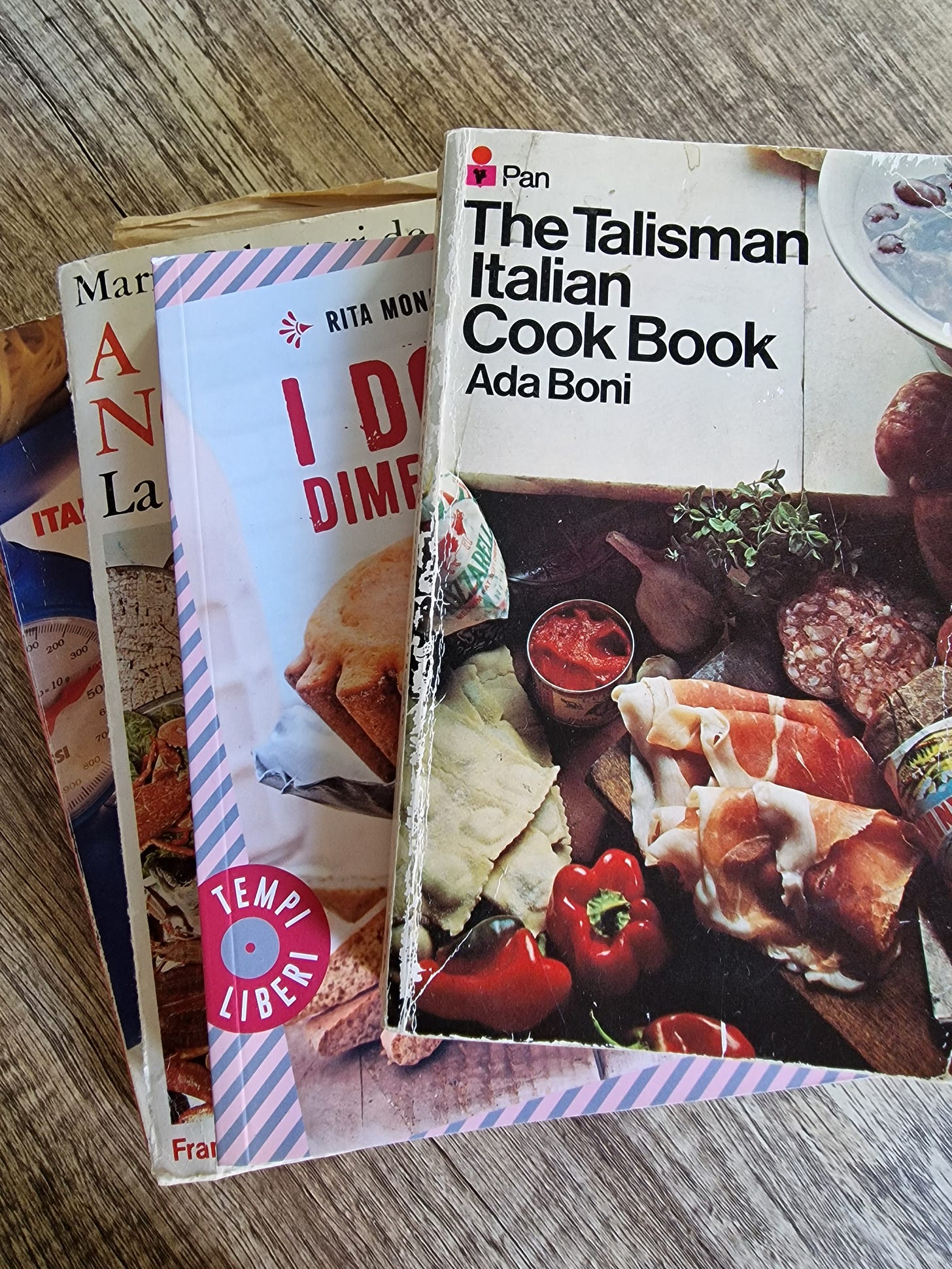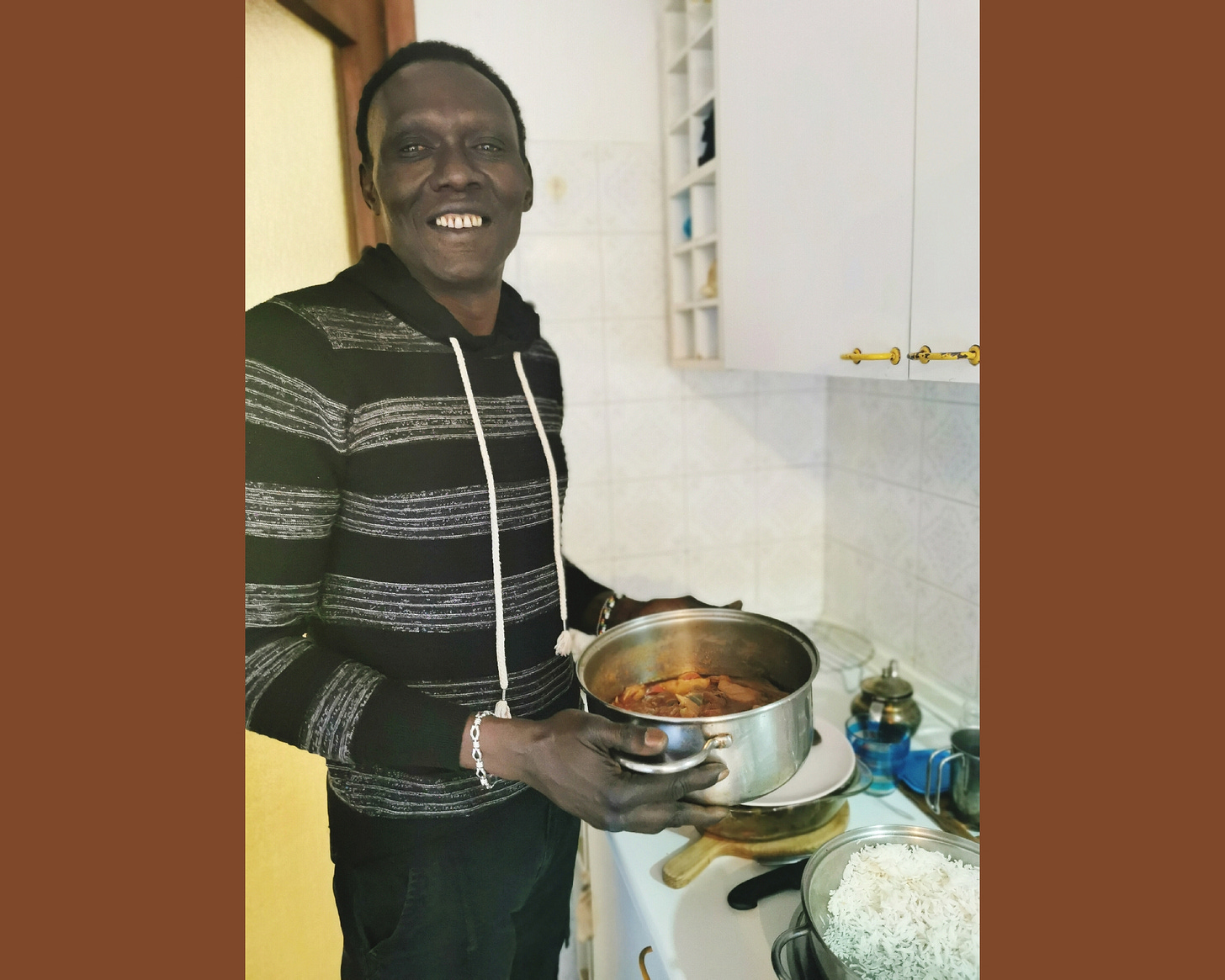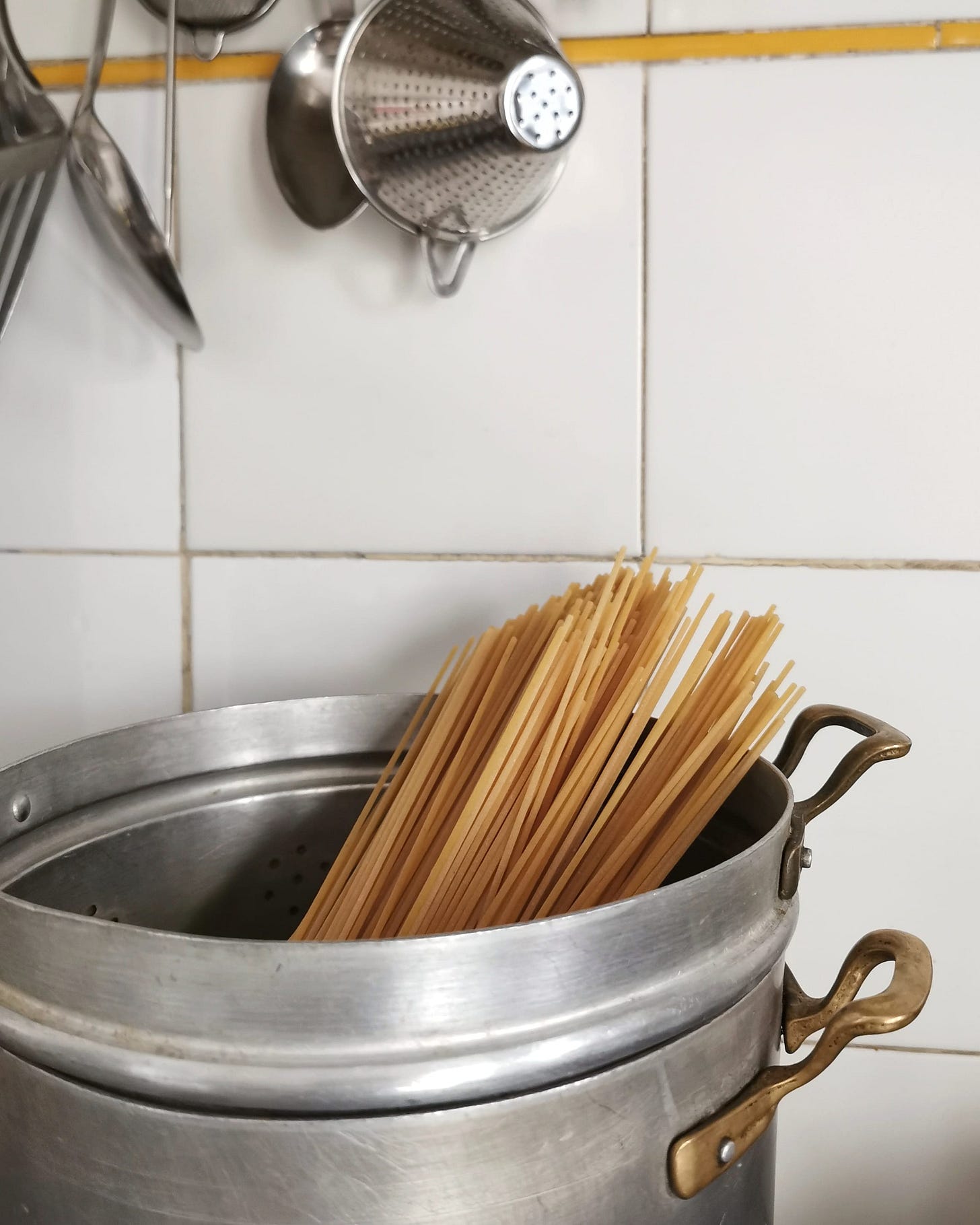All the Cookbooks I Love
One year as a cookbook owner, diasporic cooking & book recommendations
A MESSAGE FROM THE AUTHOR
Dear readers, let me apologize for the radio silence.
I am well, albeit a little shaken due to some family situations that developed this summer. I’ve been living off of crackers, take-outs and pasta (thank God we have pasta), and everything I wrote felt too raw to publish.
Today, however, marks a special anniversary: my first year as a cookbook owner (since I was 11).
To celebrate, I’m sharing some of the food books that I’ve collected since August 9, 2021. And for those of you waiting, soon I’ll announce the results of the poll we did in May :)
Thank you for being here, you’re the best readers in the world.
Ps: Hello new subscribers! Check out the about and archive pages to learn more about me + this publication.
Loss, gain, and the cookbooks in between
When my family split, in 2003, we left our home and everything in it, behind us. Sadly, among the casualties of a failed marriage was my first and only cookbook: a large red binder filled with recipe cards I’d collected with feverish religious fervour and which I still remember with fondness.
Growing up, I traveled light, and owned very little - a consequence of having experienced the pain that comes with parting with people, objects and the memories they both hold.
At 35, and fairly settled down, I sometimes wonder how did my paternal grandparents feel when they left their village for Germany, back in the 50s. A whole life in a suitcase. What did they pack? Certainly, not cookbooks (neither of them was much of a cook) but perhaps some sort of utensil. A pair of handmade knives our family is known for all around the world? Or simply a couple of drop-shaped caciotte and a few sheets of flat bread for the road.
Today, in most urban centres of Italy you can find foreign grocery items quite easily. Baba, my mom's partner, who is from the Gambia, likes to go on short walks around the neighbourhood to shop for fresh paprika, unrefined palm oil, boxes of dried mint leaves and so much more. When he came to Italy on a boat his sole belonging was the clothes he wore; in his head, however, plenty of knowledge, memories, and recipes, too.
Baba makes a strong mint tea that can bring a dead man back to life (I learnt to avoid it past 2 pm), and eats mounds of white rice with peanut “sauce” - mostly fish or chicken based but he's happy to improvise a vegetarian version for me anytime. I could eat the whole thing straight from the pot while talking about the many virtues of paprika with him.
This is a Gambian cookbook I’d like to own one day.
Did they have pasta in 1950s German supermarkets? Did they even have supermarkets? I don’t know much about them, but I’m pretty sure that cooking even the most basic dish was not an easy task for my grandparents. And now, 70 years later, my uncle owns a popular pizzeria in Gütersloh and my beautiful aunt Veronica runs two gelato places in nearby towns. My cousins don’t speak a word of Italian but they surely know what a good pizza and gelato taste like.
I read somewhere that Ada Boni’s “The Talisman” was THE cookbook many Italian mothers gifted to their daughters before they’d marry, especially when the latter were to leave for North America1 - a talisman for good luck, indeed. Several of those young girls’ daughters would then use the book themselves to learn about Italian cooking, passing it down to younger generations as an umbilical cord to a motherland they’d never known.
Migrant Italian cuisine has evolved greatly since it landed in America, and to this day, in its new, independent form, it holds the dignity of the complex experience of loss and gain that is the global Italian diaspora.
This cookbook about modern Italian-American cuisine intrigues me.
Recently, I particularly enjoyed this newsletter about the Italian-Canadian garden by oral history expert Cassandra Marsillo.
Those of you of Italian descent, have you ever heard of Ada Boni’s The Talisman?
All the Cookbooks I Love
Today, August 9, marks one full year of being a cookbook owner again since I was 11. With great amazement, last year I started buying food books, most of which are the heavy, bulky, hard-cover image of a nomad’s nightmare.
Picking up where I left off feels particularly emotional - second chances in life are such a rare gift, and worth remembering and celebrating.
Below is a list of some of those food books that accompanied me in the past year of learning to cook… and finding myself. Feel free to share thoughts + your own book recommendations in the comments.
1. A Short History of Spaghetti with Tomato Sauce by Massimo Montanari
A tiny book with a big message, written by food historian Massimo Montanari. Interestingly, the English version lacks the first part of the original title: “The Myth of the Origins”, which is crucial to understanding the meaning that the book carries. What could seem, at first glance, a banal reinforcement of what everyone knows - pasta is a fundamental part of our identity as Italians - it tells the story of a symbol that is anything but "national". Pasta, as you'll learn, is the result of an endless cultural, social and economic exchange among various cultures, silently transporting into the future the gene of diversity, rather than that of homogeneity. In the 21st century, with the migration crisis and nationalist movements on the rise, this book should be taught in schools, at least in Italian ones. Maybe we would finally start looking at "others" as "us". I binged on this book as I would with a generous plate of pasta on a Sunday lunch. I'm sure you will, too (Italian version). Another great (and extensive) read about the cultural history of Italian cuisine is Italian Cuisine: A Cultural History by Alberto Capatti & Massimo Montanari (Italian version). If you're a fan of British cuisine or simply like to dig into the folds of history and society, then this book is also for you: Scoff -A History of Food and Class in Britain by Pen Vogler.
2. French Country Cooking by Mimi Thorisson
This is the cookbook I bought on August 9, 2021. The first after a 25-year-long break. When I need inspiration or a bit of daydreaming, inevitably, I open French Country Cooking and hide in its world of freshly baked pies and rustic tables. Now, I know that there are more iconic cookbooks one should look up to, but social media has been the door through which I entered the food world, starting with food photography even before cooking. About envy-inducing Mimi: by all means, she is the perfect lifestyle Instagram influencer: effortlessly beautiful, mother to many, many kids, and beloved wife to a talented photographer husband. Oh, right, apparently she can cook, too, and her French kitchen is simply a dream! I totally understand why many are irritated by her, and to be honest, I found myself wondering how does she do it all and so well. But at the end of the day that's not what I care about... the photography and mood of her books and blog are very unique to her (and her husband). I couldn't help but swoon in front of such beauty when I first discovered their work. Once I got the books and tried out recipes I realized this couple simply nails everything they do. They're great communicators, storytellers and marketers, and I intend to give them credit for their talent and creativity fully. They managed to create a unique brand identity for themselves and that's admirable.
3. How to Cook a Wolf by M.F.K. Fisher
… where "a wolf" is hunger in wartime years. Written during WWII, this book is smart, ironic and chock-full of ideas to economise on gas while still managing to pull off decent meals. Many call Mrs Fisher the best Food Writer of all time, and I'm inclined to agree. On a similar note, in the late 1800s and early 1900s in Italy, Amalia Moretti Foggia wrote a widely renowned recipe newspaper column in La Domenica del Corriere under the pseudonym of "Petronilla" - a wise matron set to help Italian wives prepare nutritious meals for their families even in the face of economic restraints. In 1937, out of popular demand, a cookbook was published which sold out immediately. Importantly, Amalia, who had earned two university degrees and, in fact, was the third woman to earn a degree in medicine in 1898, was also writing a medical column in the same paper, dispensing crucial health information in the guise of a male doctor, Doctor Amal that is, simply because no one would ever take medical advice from a woman. Today, her recipes are collected in this cookbook: Le Ricette di Petronilla - only available in Italian, as far as I'm aware. If you know of an English version, I'd be grateful if you could let me know.
4. Serious Eater by Ed Levine
An adrenaline-filled story of how young and orphaned Ed Levine, in the face of huge financial challenges and childhood trauma, developed into the broke idealist, but ultimately successful, founder of Serious Eats - one of the first food and recipe blogs in the United States. Ed's food platform was born "to change and democratize the food culture through food media without dumbing it down or pandering" - which sounds nice to me, especially in the light of current social media trends that make anything food-related feel exclusive or "expensive". At Serious Eats, you'll find a blog section dedicated to food history (as well as to food science) with lots of insightful reads.
5. My Life in France by Julia Child & Alex Prud’homme
Did you know that joy and fun are the two emotions Julia Child associates with cooking most often? In her biography (written with her grand-nephew Alex Prud’homme) she can't stop reiterating how fun learning to cook was and how much joy it brought her, a 37-year-old woman who was still discovering herself. If you haven't, do read the book. Julia’s husband, Paul Child, was a phenomenal photographer, and partner, too. The more I look at the photos he took - sure, lots of Paris views but mainly he and Julia - the more I realize how glorious it is to witness a love story made of two middle-aged, physically imperfect, highly creative people. I want more of this. And why not, shouldn't we all chronicle life in writing and images? I'd love for those who'll come after me to know how we lived and how much we loved each other, albeit normally and specially at the same time.
6. A Tola Co I Nostri Veci by Mariù Salvatori De Zuliani (Vintage Venetian Cuisine)
This is the vintage Venetian recipe book I use to test recipes for Dash of Prosecco. The title literally translates into "At the table with our old ones" and it’s considered the Bible of Venetian cuisine, with hundreds of traditional Venetian recipes from the ol’ days. Two things set this book apart, in my opinion: 1) the language: written in Venetian dialect, rather than Italian, it’s jam-packed with fun expressions and notes that truly make you giggle or scratch your head as you read (listen to a narrated recipe from the book); 2) the origins: popular recipes of cucina povera sit next to recipes from the archives of noble or rich families. In terms of content, the book is very oriented toward fish-based recipes, as you can imagine, although there's also a huge section on vegetables, cheese and eggs.
7. The Kitchen Diaries (Vol. I, II, III) by Nigel Slater
Nigel Slater writes down every meal he cooks. Out of this habit was born a series of three, gently narrated cookbooks. If I had to choose one author for my very personal recipe writing award, that would be Nigel. What others achieve through careful storytelling, photography and intelligent marketing he can condense into a simple, well-written recipe just with a pen. The Kitchen Diaries have, in fact, become my bible - they sit on my bedside table filled with earmarked annotations about the magic this man can conjure through style, cadence, and choice of words. Anyone who's interested in the topic of food writing should study his work by heart.
8. Tender Volume I & Volume II by Nigel Slater
From the moment I decided I wanted to learn to cook, cookbooks and all sorts of food books have been piling up high on every free surface of my house. I read them thoroughly, every evening, and more often than not, I forget what I learned by the time the first morning light hits our windows. Inspiration is what remains, not recipes. Processes, ideas, and ways to approach ingredients that I haven’t considered before. These two books offer whole chapters on selected vegetables and fruits, including descriptions of varieties, tips on how to grow them, and most importantly, food pairings to enhance the flavour. This is highly recommended to anyone interested in gaining a better understanding of vegetables and fruits, as well as acquiring an inquisitive approach to self-learning in the kitchen.
About Me
My name is Sinù Fogarizzu and I’m a vegetarian food writer from the mainland of Venice, Italy. In 2021, I launched Dash of Prosecco, a Substack newsletter about learning to cook, identity and Venetian cuisine. I’m on Instagram & Twitter.









Thank you so much for the shout out 🥰 I enjoyed reading your reflections and HEAVILY relate to this: "more often than not, I forget what I learned by the time the first morning light hits our windows. Inspiration is what remains, not recipes." I have been so hard on myself about this, expecting myself to remember everything I read and learn, and getting frustrated when I can't. But this is such a good way to look at it - the inspiration remains, and that's what counts. Because the info can be sought out again, anytime. My most precious cookbooks at the moment are the two volumes of "La cucina molisana," which was published in the 80s. Impossible to find new copies (these are my nonna's). We cherish them!
Loved reading about your experience, Sinù. It makes me think of the blank cookbook I bought when I was probably about 11. It had a red and white checkboard cover and I filled it with all of the cookie recipes that my mom and I made while I was growing up. It's since fallen apart, but I loved flipping through it as I made the same cookies with my son years later. And thank you for the cookbook recs, there are a few I added to my list!